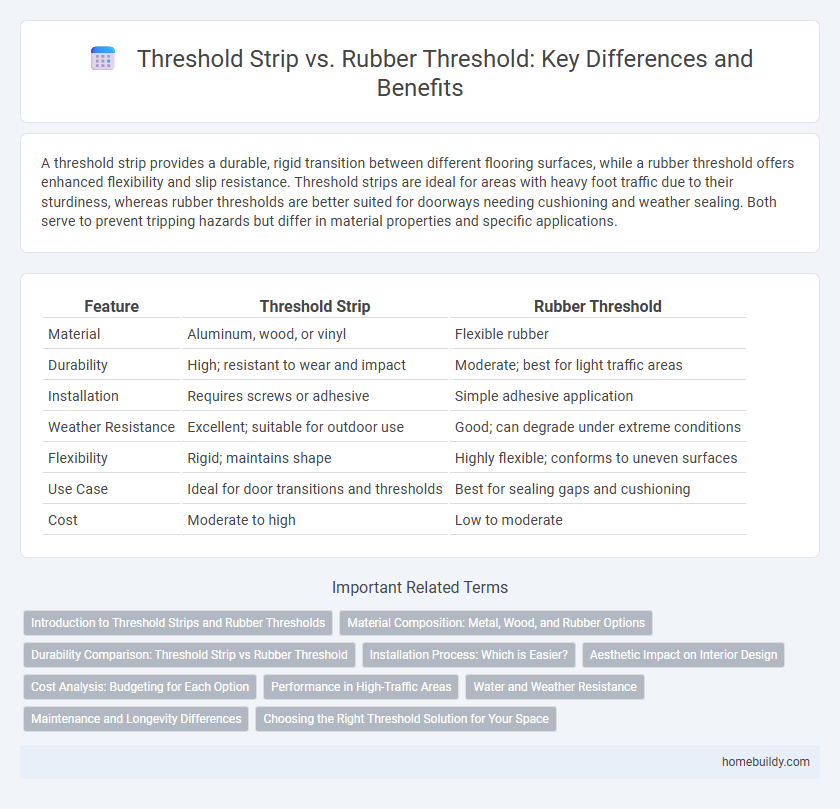A threshold strip provides a durable, rigid transition between different flooring surfaces, while a rubber threshold offers enhanced flexibility and slip resistance. Threshold strips are ideal for areas with heavy foot traffic due to their sturdiness, whereas rubber thresholds are better suited for doorways needing cushioning and weather sealing. Both serve to prevent tripping hazards but differ in material properties and specific applications.
Table of Comparison
| Feature | Threshold Strip | Rubber Threshold |
|---|---|---|
| Material | Aluminum, wood, or vinyl | Flexible rubber |
| Durability | High; resistant to wear and impact | Moderate; best for light traffic areas |
| Installation | Requires screws or adhesive | Simple adhesive application |
| Weather Resistance | Excellent; suitable for outdoor use | Good; can degrade under extreme conditions |
| Flexibility | Rigid; maintains shape | Highly flexible; conforms to uneven surfaces |
| Use Case | Ideal for door transitions and thresholds | Best for sealing gaps and cushioning |
| Cost | Moderate to high | Low to moderate |
Introduction to Threshold Strips and Rubber Thresholds
Threshold strips provide a durable and often metal or plastic solution for covering gaps between flooring surfaces, enhancing both safety and aesthetics. Rubber thresholds offer superior flexibility and cushioning, ideal for absorbing impact and accommodating uneven surfaces. Both types serve crucial roles in transition applications, but rubber thresholds excel in noise reduction and slip resistance.
Material Composition: Metal, Wood, and Rubber Options
Threshold strips offer a variety of material compositions including metal, wood, and rubber, each tailored for specific durability and aesthetic needs. Metal threshold strips, typically made from aluminum or stainless steel, provide high durability and corrosion resistance ideal for heavy traffic areas. Wood threshold strips add a warm, natural look but require sealing to prevent moisture damage, while rubber thresholds offer flexibility and excellent weather sealing for doorways exposed to the elements.
Durability Comparison: Threshold Strip vs Rubber Threshold
Threshold strips exhibit superior durability compared to rubber thresholds, owing to their construction from robust materials such as aluminum or stainless steel that resist wear and environmental damage. Rubber thresholds tend to degrade faster under heavy foot traffic and exposure to UV rays, leading to cracking and deformation over time. The long-lasting nature of threshold strips makes them ideal for high-traffic areas demanding consistent performance and minimal maintenance.
Installation Process: Which is Easier?
Threshold strips typically feature pre-drilled holes and require straightforward screwing or nailing during installation, which allows for quick and secure attachment to doorways. Rubber thresholds often rely on adhesives or require precise fitting and trimming, making the installation process more labor-intensive and potentially messier. The rigid structure of threshold strips generally makes them easier and faster to install compared to the flexible and sometimes pliable rubber thresholds.
Aesthetic Impact on Interior Design
Threshold strips offer a sleek, minimalistic appearance that seamlessly integrates with various interior design styles, enhancing the visual flow between rooms. Unlike rubber thresholds, which can appear bulky and utilitarian, threshold strips provide a refined finish that complements hardwood, tile, and carpet flooring. Their availability in multiple finishes and colors allows designers to maintain aesthetic consistency and elevate the overall ambiance of the space.
Cost Analysis: Budgeting for Each Option
Threshold strips generally present a lower initial cost compared to rubber thresholds, making them a budget-friendly choice for short-term projects. Rubber threshold options, while more expensive upfront, offer superior durability and better resistance to wear in high-traffic areas, potentially reducing long-term replacement costs. Careful cost analysis should consider installation expenses, material longevity, and maintenance requirements to determine the most economical solution over time.
Performance in High-Traffic Areas
Threshold strips made from durable materials like aluminum or stainless steel provide superior performance in high-traffic areas due to their resistance to wear, impact, and weather conditions. Rubber threshold strips offer excellent cushioning and noise reduction but tend to degrade faster under heavy footfall and frequent use. For long-lasting durability and minimal maintenance in busy environments, metal threshold strips are the optimal choice.
Water and Weather Resistance
Threshold strips made from aluminum or vinyl offer superior water and weather resistance compared to rubber thresholds, effectively preventing water infiltration and minimizing damage caused by prolonged exposure to harsh weather conditions. Rubber thresholds can degrade over time due to UV exposure and temperature fluctuations, leading to cracks and reduced waterproofing performance. Using metal or vinyl threshold strips enhances durability and maintains a watertight seal for entryways in diverse environmental conditions.
Maintenance and Longevity Differences
Threshold strips typically require less maintenance than rubber thresholds due to their rigid materials, which resist wear and deformation over time. Rubber thresholds, while providing excellent flexibility and shock absorption, tend to degrade faster in high-traffic areas, necessitating more frequent replacement and upkeep. The longevity of threshold strips often surpasses rubber options by several years, making them a cost-effective solution for durable door sealing and transition needs.
Choosing the Right Threshold Solution for Your Space
Threshold strips offer a more rigid and durable solution compared to rubber thresholds, making them ideal for high-traffic areas or doorways requiring firm support. Rubber thresholds provide excellent flexibility and cushioning, perfect for uneven surfaces and minimizing noise or vibration. Choosing the right threshold depends on factors such as durability requirements, surface conditions, and desired aesthetic, ensuring optimal performance and longevity in your space.
threshold strip vs rubber threshold Infographic

 homebuildy.com
homebuildy.com